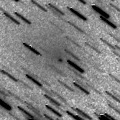
|
It brightened rapidly as expected. Now it is so bright as 7.9 mag (Oct. 16, Juan Jose Gonzalez). It will pass the perihelion on Nov. 21, and will brighten up to 7 mag. In the Northern Hemisphere, it keeps observable in good condition in the morning sky until mid November. But it will be getting lower rapidly after this. It is not observable in the Southern Hemisphere.
Date(TT) R.A. (2000) Decl. Delta r Elong. m1 Best Time(A, h)
Oct. 19 10 38.15 31 7.5 0.480 0.854 58 8.2 3:44 (236, -7)
Oct. 26 11 49.39 19 12.0 0.522 0.729 45 7.9 3:33 (253,-10)
|

|
New bright comet. Now it is 8.7 mag (Oct. 16, Juan Jose Gonzalez). It will pass only 0.4 A.U. from the earth, and 0.8 A.U. from the sun in November and December, and will brighten up to 5 mag. In the Northern Hemisphere, it keeps observable in excellent condition for a long time until 2014 autumn when the comet will fade out. In the Southern Hemisphere, it will not be observable from mid November to early February. But it keeps observable in good condition until mid November when the comet will brighten up to 6 mag.
Date(TT) R.A. (2000) Decl. Delta r Elong. m1 Best Time(A, h)
Oct. 19 7 16.04 2 3.2 0.922 1.415 94 8.8 3:44 (218, 46)
Oct. 26 7 38.48 6 2.2 0.761 1.322 96 8.1 3:33 (217, 42)
|
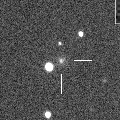
|
Although it was predicted to be 14 mag, it is extremely bright as 8.5 mag in outburst now (Oct. 20, Hidetaka Sato). It will be observable in excellent condition in 2014 spring. In the Northern Hemisphere, it will be getting higher gradually in the morning sky. In the Southern Hemisphere, it is not observable until 2014 February.
Date(TT) R.A. (2000) Decl. Delta r Elong. m1 Best Time(A, h)
Oct. 19 12 59.54 25 6.4 3.019 2.289 36 8.5 3:44 (259,-31)
Oct. 26 13 17.05 23 57.5 2.928 2.229 37 8.3 3:33 (261,-30)
|
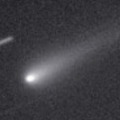
|
Now it is 9.7 mag (Oct. 16, Syogo Utsunomiya). It will approach to the sun down to only 0.01 A.U. on Nov. 28, and is expected to be a great comet. It keeps visible with naked eyes from November to January, and can be extremely bright as Venus or more at the highlight. But recently, it is fainter than originally expected by 2-3 mag. It may be 3 mag at best actually when it is observable in the morning sky. The condition is excellent in the Northern Hemisphere. It keeps observable almost all through the period of brightening, at the highlight, and of fading. The condition is not good in the Southern Hemisphere. It is not observable at all the latter part of the highlight, and it keeps low all through the period.
Date(TT) R.A. (2000) Decl. Delta r Elong. m1 Best Time(A, h)
Oct. 19 10 20.74 12 43.4 1.611 1.291 53 9.9 3:44 (249, 7)
Oct. 26 10 45.56 9 45.7 1.402 1.137 53 9.2 3:33 (252, 7)
|
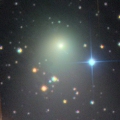
|
It became much brighter than expected. Now it is so bright as 8.9 mag (Oct. 12, Michael Mattiazzo). In the Southern Hemisphere, it will keep observable in good condition for a long time until 2014 summer when the comet fades out. It will never be observable again in the Northern Hemisphere.
Date(TT) R.A. (2000) Decl. Delta r Elong. m1 Best Time(A, h)
Oct. 19 10 45.63 -42 42.5 2.179 1.706 49 9.9 3:44 (303, 31)
Oct. 26 11 9.12 -46 28.9 2.229 1.758 49 10.2 3:33 (308, 31)
|
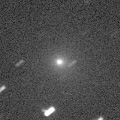
|
It brightened very rapidly. Now it is so bright as 10.8 mag (Oct. 11, Seiichi Yoshida). It keeps bright as 10 mag from autumn to winter. In the Northern Hemipshere, it keeps observable in excellent condition until the comet fades out. In the Southern Hemisphere, it keeps observable in good condition within 2013, but it will not be observable in 2014.
Date(TT) R.A. (2000) Decl. Delta r Elong. m1 Best Time(A, h)
Oct. 19 21 58.43 -2 40.5 0.941 1.716 124 11.6 20:06 (180, 57)
Oct. 26 22 0.53 -0 46.3 0.970 1.691 118 11.3 19:55 (174, 55)
|

|
Now it is 10.8 mag (Oct. 12, Seiichi Yoshida). It keeps 11-13 mag until autumn, but it keeps locating extremely low in the morning sky. It is not observable until November in the Southern Hemisphere.
Date(TT) R.A. (2000) Decl. Delta r Elong. m1 Best Time(A, h)
Oct. 19 11 31.12 -3 13.2 2.256 1.499 31 12.5 3:44 (272, 2)
Oct. 26 11 44.38 -6 49.6 2.280 1.561 34 12.7 3:33 (275, 5)
|

|
It approached to the sun down to 0.73 A.U. on Mar. 24, and brightened up to 4.7 mag (Mar. 11, Michael Mattiazzo). Now it is fading. But it is still bright as 11.7 mag (Oct. 13, Seiichi Yoshida). In the Northern Hemisphere, it keeps observable in good condition while fading gradually. In the Southern Hemisphere, it will never be observable again.
Date(TT) R.A. (2000) Decl. Delta r Elong. m1 Best Time(A, h)
Oct. 19 18 43.13 54 28.0 3.122 3.288 90 12.6 19:46 (156, -7)
Oct. 26 18 46.96 53 8.7 3.236 3.371 89 12.8 19:55 (151, -9)
|

|
Now it is 12.4 mag (Oct. 3, Sandor Szabo). It keeps bright at 13-14 mag for a long time until 2014. It keeps observable for a long time in the Northern Hemisphere. It locates somewhat low in the Southern Hemisphere.
Date(TT) R.A. (2000) Decl. Delta r Elong. m1 Best Time(A, h)
Oct. 19 19 15.97 14 54.3 5.948 5.997 88 13.5 19:46 (140, 30)
Oct. 26 19 15.73 13 41.5 6.061 6.006 82 13.6 19:55 (131, 26)
|

|
Now it is 14.0 mag and visible visually (Sept. 6, Sandor Szabo). It is expected to brighten up to 5-6 mag in 2014 autumn. In the Northern Hemisphere, it keeps observable in good condition for a long time, although it will be unobservable temporarily in late November. In the Southern Hemisphere, it will not be observable until 2014 February.
Date(TT) R.A. (2000) Decl. Delta r Elong. m1 Best Time(A, h)
Oct. 19 15 42.47 12 18.4 4.994 4.262 38 13.8 19:46 (101, -6)
Oct. 26 15 45.13 11 47.8 4.963 4.191 35 13.7 19:55 ( 96,-13)
|

|
Big asteroid discovered in 1906. It suddenly showed the cometary activity on Dec. 11, 2010, probably due to an impact of a small object. It has already turned to be stellar.
Date(TT) R.A. (2000) Decl. Delta r Elong. m1 Best Time(A, h)
Oct. 19 0 22.37 -17 59.7 2.217 3.099 146 13.7 22:29 (180, 73)
Oct. 26 0 17.77 -17 47.3 2.278 3.109 140 13.9 21:57 (180, 73)
|

|
It brightened up to 11-12 mag in 2012. Now it is bright as 13.7 mag (July 24, Taras Prystavski). It is not observable now. However, it will be observable again at 14 mag after late November in the Northern Hemisphere, or mid December in the Southern Hemisphere.
Date(TT) R.A. (2000) Decl. Delta r Elong. m1 Best Time(A, h)
Oct. 19 13 21.65 -12 7.0 7.557 6.564 3 13.9 3:44 (296,-14)
Oct. 26 13 23.28 -12 23.8 7.574 6.595 9 13.9 3:33 (294,-11)
|

|
Now it is 13.4 mag and visible visually (Oct. 12, Seiichi Yoshida). It keeps 13-14 mag and observable in good condition in the Northern Hemisphere for a long time from 2013 to 2014. In the Southern Hemisphere, it is not observable until 2014 autumn.
Date(TT) R.A. (2000) Decl. Delta r Elong. m1 Best Time(A, h)
Oct. 19 11 4.81 63 58.8 3.548 3.499 79 14.0 3:44 (210,-28)
Oct. 26 11 17.58 66 16.7 3.446 3.488 84 14.0 3:33 (207,-28)
|

|
Not observable now. It will appear in the morning sky again in late December.
Date(TT) R.A. (2000) Decl. Delta r Elong. m1 Best Time(A, h)
Oct. 19 14 30.78 -23 24.6 7.122 6.189 19 14.2 19:46 ( 61, 1)
Oct. 26 14 36.32 -23 47.8 7.147 6.188 14 14.2 19:55 ( 57, -4)
|
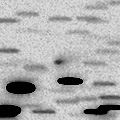
|
First return of a new periodic comet discovered in 1998. It brightened up to 10 mag at the discovery. Now it is 14.6 mag (Oct. 13, Seiichi Yoshida). In the Northern Hemisphere, it keeps observable in excellent condition from autumn to spring. A bit fainter than originally expected, but it will brighten up to 12 mag. It locates somewhat low in the Southern Hemisphere.
Date(TT) R.A. (2000) Decl. Delta r Elong. m1 Best Time(A, h)
Oct. 19 6 34.12 41 32.8 2.045 2.534 107 14.7 3:44 (192, 12)
Oct. 26 6 41.09 41 39.1 1.939 2.502 113 14.4 3:33 (190, 12)
|
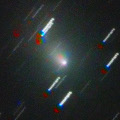
|
It brightened up to 9-10 mag in 2013 spring. Now it is fading. It has already faded down to 14.6 mag (Aug. 28, Hidetaka Sato). In the Southern Hemisphere, it keeps observable for a long time until the comet fades out, although it keeps locating low. It will never be observable again in the Northern Hemisphere.
Date(TT) R.A. (2000) Decl. Delta r Elong. m1 Best Time(A, h)
Oct. 19 12 21.37 -57 1.7 3.155 2.616 49 14.7 3:44 (325, 23)
Oct. 26 12 44.76 -58 28.7 3.240 2.684 48 14.9 3:33 (327, 23)
|
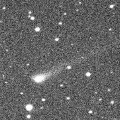
|
Now it is 14.3 mag (July 8, Chris Wyatt). It keeps bright as 13-14 mag for a long time from 2013 to 2014. In the Northern Hemisphere, it is already unobservable. It will be unobservable soon also in the Southern Hemisphere, but it will appear in the morning sky again in 2014 February.
Date(TT) R.A. (2000) Decl. Delta r Elong. m1 Best Time(A, h)
Oct. 19 15 46.78 -21 12.9 3.935 3.154 33 15.0 19:46 ( 73, 14)
Oct. 26 15 57.36 -21 53.5 3.976 3.146 29 15.0 19:55 ( 70, 9)
|

|
The condition is worst and the comet will be hardly observable in this apparition. Now it is appearing in the morning sky in the Northern Hemisphere. But it locates extremely low.
Date(TT) R.A. (2000) Decl. Delta r Elong. m1 Best Time(A, h)
Oct. 19 12 10.04 7 21.4 2.477 1.656 27 15.1 3:44 (269,-12)
Oct. 26 12 25.78 5 55.4 2.504 1.716 29 15.6 3:33 (270,-11)
|
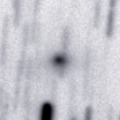
|
It brightened up to 2 mag by unusual major outburst in 2007. It will return in 2014. It will be 14 mag at best by normal prediction. But actually, it is brighter than predicted. It has already brightened up to 15.2 mag (Sept. 22, J. F. Hernandez).
Date(TT) R.A. (2000) Decl. Delta r Elong. m1 Best Time(A, h)
Oct. 19 18 11.15 -32 50.9 2.594 2.390 67 15.3 19:46 ( 78, 48)
Oct. 26 18 23.73 -31 57.2 2.646 2.364 62 15.2 19:55 ( 77, 43)
|
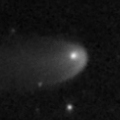
|
Now it is 15.7 mag (Oct. 11, Ken-ichi Kadota). It keeps 15 mag and observable in good condition in 2013. It locates somewhat low in the Northern Hemisphere.
Date(TT) R.A. (2000) Decl. Delta r Elong. m1 Best Time(A, h)
Oct. 19 3 54.64 -25 52.7 6.518 7.207 130 15.3 2:06 (180, 81)
Oct. 26 3 50.37 -25 53.8 6.518 7.238 133 15.3 1:34 (180, 81)
|
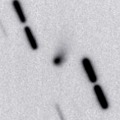
|
Now it is 15.7 mag (Oct. 8, K. Hills). It is expected to brighten up to 7.5 mag and to be observable in excellent condition from summer to autumn in 2014 in the Southern Hemisphere. The condition is bad in the Northern Hemisphere. It will pass extremely close to Mars in 2014 October.
Date(TT) R.A. (2000) Decl. Delta r Elong. m1 Best Time(A, h)
Oct. 19 5 23.08 -30 28.5 4.219 4.684 111 15.5 3:34 (180, 85)
Oct. 26 5 16.78 -32 2.9 4.101 4.618 115 15.4 3:00 (180, 87)
|
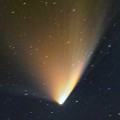
|
It passed the perihelion on Mar. 10, and brightened up to 0-1 mag. Now it is fading. It has already faded down to 14.5 mag (Oct. 3, Catalina Sky Survey). In the Northern Hemisphere, it will be very low temporarily from November to December, but it keeps observable for a long time until the comet fades out. It is not observable in the Southern Hemisphere.
Date(TT) R.A. (2000) Decl. Delta r Elong. m1 Best Time(A, h)
Oct. 19 15 51.28 29 46.5 4.304 3.766 51 15.5 19:46 (117,-14)
Oct. 26 15 58.10 28 49.1 4.414 3.849 49 15.8 19:55 (112,-19)
|
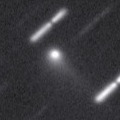
|
Brightened rapidly. Now it is visible visually at 14.3 mag (Oct. 11, Seiichi Yoshida). It keeps observable in excellent condition until autumn. Some visual observers reported it extremely bright as 12 mag in August.
Date(TT) R.A. (2000) Decl. Delta r Elong. m1 Best Time(A, h)
Oct. 19 21 24.34 4 57.2 1.567 2.215 117 15.7 19:46 (175, 50)
Oct. 26 21 30.85 5 9.2 1.648 2.232 112 15.8 19:55 (164, 49)
|

|
It brightened up to 12 mag in 2012. It is bright as 14.8 mag still now (Sept. 18, Y. Sugiyama). It will be fading and getting lower after this, and will be unobservable at 17 mag in December.
Date(TT) R.A. (2000) Decl. Delta r Elong. m1 Best Time(A, h)
Oct. 19 19 41.88 -34 29.5 3.106 3.192 85 15.7 19:46 ( 83, 66)
Oct. 26 19 49.31 -34 2.3 3.215 3.207 80 15.8 19:55 ( 81, 60)
|

|
It brightened up to 14.5 mag in July (July 16, M. Brusa, L. Sempio). Now it is fading. In the Southern Hemisphere, it keeps observable for a long time until the comet fades out. It is not observable in the Northern Hemisphere.
Date(TT) R.A. (2000) Decl. Delta r Elong. m1 Best Time(A, h)
Oct. 19 17 51.97 -42 15.0 2.627 2.373 64 15.9 19:46 ( 63, 46)
Oct. 26 17 53.45 -43 30.1 2.757 2.393 58 16.0 19:55 ( 59, 40)
|

|
It approached to the sun down to 0.14 A.U. on Oct. 7. In the Northern Hemisphere, it keeps observable at 16 mag in good condition from late October to mid December. In the Southern Hemisphere, it locates very low from November to December.
Date(TT) R.A. (2000) Decl. Delta r Elong. m1 Best Time(A, h)
Oct. 19 15 9.29 -5 48.0 0.783 0.421 23 15.9 19:46 ( 82, -2)
Oct. 26 16 19.75 -1 42.7 0.678 0.596 35 16.1 19:55 ( 90, 3)
|

|
Now it is 16.8 mag (Oct. 1, Taras Prystavski). It tends to be brightest 4 months after the perihelion passage. It will reach up to 15.5 mag from autumn to winter, and will be observable in excellent condition.
Date(TT) R.A. (2000) Decl. Delta r Elong. m1 Best Time(A, h)
Oct. 19 6 31.85 16 20.8 1.451 1.995 107 16.1 3:44 (198, 37)
Oct. 26 6 37.17 16 20.9 1.406 2.019 113 16.0 3:33 (194, 37)
|
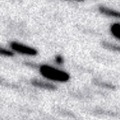
|
It reaches up to 12 mag in 2014 spring. But the condition in this apparition is bad. It locates low around the brightest days. Now it is 16.4 mag (Oct. 9, J. L. Martin). It keeps observable in good condition until winter when the comet will brighten up to 15-16 mag.
Date(TT) R.A. (2000) Decl. Delta r Elong. m1 Best Time(A, h)
Oct. 19 19 25.33 -13 14.7 2.510 2.626 85 16.3 19:46 (118, 53)
Oct. 26 19 32.02 -13 25.3 2.561 2.584 80 16.2 19:55 (110, 48)
|
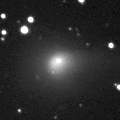
|
Fading slowly. It is bright as 14.4 mag still now (Oct. 3, Sandor Szabo). It keeps observable in good condition until the comet will be fainter than 18 mag in December.
Date(TT) R.A. (2000) Decl. Delta r Elong. m1 Best Time(A, h)
Oct. 19 0 46.98 -2 28.1 2.259 3.224 162 16.4 22:54 (180, 57)
Oct. 26 0 43.15 -3 17.6 2.366 3.294 155 16.5 22:23 (180, 58)
|
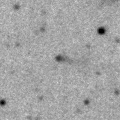
|
Now it is 17.2 mag (Oct. 9, C. Bell). It keeps 17 mag for a long time from 2013 summer to early 2015.
Date(TT) R.A. (2000) Decl. Delta r Elong. m1 Best Time(A, h)
Oct. 19 2 0.44 16 39.5 2.163 3.151 170 16.7 0:12 (180, 38)
Oct. 26 1 55.96 16 6.8 2.148 3.141 176 16.6 23:35 (180, 39)
|

|
Now it is 16.4 mag (Oct. 14, Catalina Sky Survey). It will be observable at 16 mag in good condition in summer and autumn.
Date(TT) R.A. (2000) Decl. Delta r Elong. m1 Best Time(A, h)
Oct. 19 0 12.70 10 11.3 1.408 2.368 159 16.7 22:20 (180, 45)
Oct. 26 0 11.32 8 29.7 1.463 2.390 152 16.9 21:51 (180, 47)
|

|
Now it is 18.0 mag (Oct. 3, Catalina Sky Survey). It will brighten rapidly and will be observable at 15 mag in winter in excellent condition in the Northern Hemisphere. It locates low in the Southern Hemisphere.
Date(TT) R.A. (2000) Decl. Delta r Elong. m1 Best Time(A, h)
Oct. 19 4 42.18 37 56.1 1.411 2.185 129 17.0 2:53 (180, 17)
Oct. 26 4 44.05 38 53.2 1.326 2.150 135 16.8 2:27 (180, 16)
|

|
It was observed at 15-16 mag in 2012. Now it is fading slowly. But it keeps 15.6 mag still now (Oct. 13, Catalina Sky Survey). It will be fainter than 18 mag at the end of 2013. It locates low in the Southern Hemisphere.
Date(TT) R.A. (2000) Decl. Delta r Elong. m1 Best Time(A, h)
Oct. 19 0 49.47 26 0.6 3.744 4.696 160 16.8 22:56 (180, 29)
Oct. 26 0 41.51 24 8.6 3.800 4.735 157 16.9 22:21 (180, 31)
|
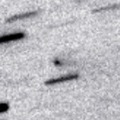
|
Now it is 18.7 mag (Sept. 27, Yasukazu Ikari). It will be observable in good condition from autumn to winter. It is expected to brighten up to 16.5 mag. But actually, it is much fainter than the ephemeris recently.
Date(TT) R.A. (2000) Decl. Delta r Elong. m1 Best Time(A, h)
Oct. 19 3 17.59 13 11.8 1.251 2.193 154 17.1 1:29 (180, 42)
Oct. 26 3 15.39 11 52.1 1.216 2.182 161 17.0 0:59 (180, 43)
|
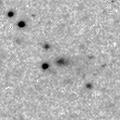
|
Now it is 17.6 mag (Oct. 11, A. Smolin). It will be observable at 17 mag in excellent condition from autumn to winter.
Date(TT) R.A. (2000) Decl. Delta r Elong. m1 Best Time(A, h)
Oct. 19 3 7.46 20 51.3 1.684 2.622 155 17.1 1:19 (180, 34)
Oct. 26 3 4.14 20 23.0 1.648 2.615 162 17.1 0:48 (180, 35)
|

|
It brightened extremely rapidly, and reached up to 15 mag in summer. It is bright as 16.2 mag still now (Sept. 29, Ken-ichi Kadota). It has already passed the perihelion, but it may keep 16 mag some more time.
Date(TT) R.A. (2000) Decl. Delta r Elong. m1 Best Time(A, h)
Oct. 19 18 46.81 -26 15.4 1.812 1.827 74 17.1 19:46 ( 92, 53)
Oct. 26 19 6.05 -26 17.7 1.897 1.855 72 17.4 19:55 ( 89, 49)
|
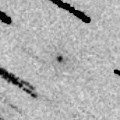
|
Although it had been fainter than expected, it is brightening now. Probably it tends to be brightest after the perihelion passage. Now it is 17.0 mag (Oct. 7, D. Buczynski). It keeps observable at 17-18 mag until December. It locates somewhat low in the Southern Hemisphere.
Date(TT) R.A. (2000) Decl. Delta r Elong. m1 Best Time(A, h)
Oct. 19 5 17.80 25 13.7 0.878 1.664 125 17.2 3:29 (180, 30)
Oct. 26 5 17.54 25 9.5 0.871 1.705 132 17.2 3:01 (180, 30)
|

|
It brightened up to 12-13 mag from autumn to winter in 2012. Now it is fading. However, it is bright as 15.9 mag still now (Oct. 9, Ken-ichi Kadota). It keeps observable for a long time until the end of 2013 when the comet becomes fainter than 18 mag.
Date(TT) R.A. (2000) Decl. Delta r Elong. m1 Best Time(A, h)
Oct. 19 6 13.48 5 7.4 3.875 4.331 110 17.3 3:44 (195, 49)
Oct. 26 6 13.27 4 10.0 3.828 4.374 117 17.3 3:33 (189, 50)
|
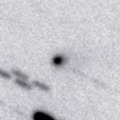
|
First return of a new periodic comet discovered in 1998. Now it is 17.6 mag (Oct. 4, K. Hills). It is fainter than originally expected by 2 mag. It was expected to be observable at 15.5 mag in good condition from 2013 autumn to early 2014. But actually, it will be 17 mag at best.
Date(TT) R.A. (2000) Decl. Delta r Elong. m1 Best Time(A, h)
Oct. 19 1 58.02 -26 26.1 1.812 2.677 143 17.3 0:09 (180, 81)
Oct. 26 1 53.06 -26 14.6 1.808 2.658 141 17.3 23:32 (180, 81)
|

|
Now it is 17.1 mag (Oct. 12, Toshiyuki Takahashi). It was observed at 18 mag in 2012. It will be observable at 17 mag in excellent condition in 2013.
Date(TT) R.A. (2000) Decl. Delta r Elong. m1 Best Time(A, h)
Oct. 19 23 2.69 -6 53.1 3.651 4.447 138 17.3 21:10 (180, 62)
Oct. 26 22 56.82 -8 31.8 3.759 4.459 129 17.4 20:37 (180, 64)
|

|
It brightened up to 9.0 mag in 2012 autumn (Nov. 4, Juan Jose Gonzalez). However, it faded out unexpectedly around the perihelion passage. Now it is fainter than originally predicted by 4-5 mag. It has already faded down to 17.4 mag (Oct. 1, K. Hills). In the Southern Hemisphere, it keeps observable in good condition while fading slowly after this. In the Northern Hemisphere, it will not be observable after this.
Date(TT) R.A. (2000) Decl. Delta r Elong. m1 Best Time(A, h)
Oct. 19 3 29.06 -53 56.8 3.289 3.774 111 17.4 1:40 ( 0, 71)
Oct. 26 3 19.64 -53 47.4 3.355 3.837 111 17.6 1:03 ( 0, 71)
|

|
Now it is 17.7 mag (July 20, A. Novichonok, T. Prystavski). It will brighten up to 14 mag around the perihelion passage in 2019. In 2013, it will be observable in good condition at 17.5 mag from summer to winter. It locates low in the Southern Hemisphere.
Date(TT) R.A. (2000) Decl. Delta r Elong. m1 Best Time(A, h)
Oct. 19 3 3.08 27 8.8 12.953 13.848 152 17.5 1:14 (180, 28)
Oct. 26 3 1.13 27 11.3 12.883 13.819 159 17.5 0:45 (180, 28)
|
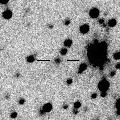
|
Now it is 17.4 mag (Sept. 28, Yasukazu Ikari). It keeps observable at 18 mag for a long time from 2013 to 2016. It keeps locating high in the Northern Hemisphere. It keeps locating very low in the Southern Hemipshere.
Date(TT) R.A. (2000) Decl. Delta r Elong. m1 Best Time(A, h)
Oct. 19 18 34.55 24 13.2 6.872 6.781 80 17.5 19:46 (137, 16)
Oct. 26 18 34.68 23 57.6 6.940 6.767 75 17.5 19:55 (130, 11)
|
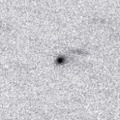
|
Now it is 17.4 mag (Sept. 25, Catalina Sky Survey). Brighter than origianlly predicted. It will be observable at 12-13 mag in excellent condition from 2014 summer to 2015 spring. In the Southern Hemisphere, it will locate low around the highlight.
Date(TT) R.A. (2000) Decl. Delta r Elong. m1 Best Time(A, h)
Oct. 19 0 29.48 -7 53.9 2.584 3.516 155 17.6 22:37 (180, 63)
Oct. 26 0 24.70 -8 5.2 2.593 3.479 148 17.5 22:04 (180, 63)
|

|
Now it is 17.8 mag (Oct. 11, Ken-ichi Kadota). It keeps observable at 17.5 mag in good condition from autumn to winter.
Date(TT) R.A. (2000) Decl. Delta r Elong. m1 Best Time(A, h)
Oct. 19 7 9.82 16 33.3 1.670 2.070 98 17.8 3:44 (208, 34)
Oct. 26 7 17.03 16 41.1 1.615 2.091 103 17.7 3:33 (205, 34)
|

|
Now it is 17.7 mag (Oct. 3, K. Hills). It keeps 17 mag for a long time from 2012 to 2013, and will be observable in good condition in the Southern Hemisphere. It is not observable at all in the Northern Hemisphere.
Date(TT) R.A. (2000) Decl. Delta r Elong. m1 Best Time(A, h)
Oct. 19 20 46.45 -68 50.6 5.186 5.231 87 17.8 19:46 ( 8, 56)
Oct. 26 20 41.96 -67 7.8 5.287 5.251 82 17.8 19:55 ( 16, 55)
|
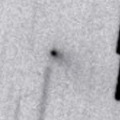
|
Now it is 17.6 mag (Oct. 13, Catalina Sky Survey). It will brighten up to 17 mag and will be observable in good condition from summer to autumn.
Date(TT) R.A. (2000) Decl. Delta r Elong. m1 Best Time(A, h)
Oct. 19 23 29.18 29 57.7 1.113 2.009 144 17.8 21:36 (180, 25)
Oct. 26 23 24.03 30 18.2 1.160 2.021 139 17.9 21:04 (180, 25)
|
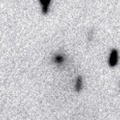
|
Now it is 18.1 mag (Oct. 8, K. Hills). In the Southern Hemisphere, it keeps observable in good condition for a long time while fading gradually. In the Northern Hemisphere, it keeps extremely low.
Date(TT) R.A. (2000) Decl. Delta r Elong. m1 Best Time(A, h)
Oct. 19 5 44.63 -45 50.3 5.016 5.300 101 17.9 3:44 (350, 79)
Oct. 26 5 40.40 -46 10.0 5.016 5.339 103 17.9 3:23 ( 0, 79)
|
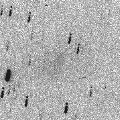
|
It will approach to the Sun down to 0.9 A.U., and to the Earth down to 0.4 A.U. in September. So it was expected to brighten up to 11-12 mag. However, it looked extremely diffuse on July 12 by Michael Jager. So the comet could be already disintegrated at that time. No observations have been reported after that. It keeps locating in good condition after this in the Southern Hemisphere. It is not observable in the Northern Hemisphere.
Date(TT) R.A. (2000) Decl. Delta r Elong. m1 Best Time(A, h)
Oct. 19 21 54.83 -71 18.5 0.724 1.242 91 21.1 20:08 ( 0, 54)
Oct. 26 23 1.78 -68 56.6 0.823 1.321 92 21.7 20:46 ( 0, 56)
|
|
![]()
 17P/Holmes
17P/Holmes C/2009 F4 ( McNaught )
C/2009 F4 ( McNaught ) C/2013 A1 ( Siding Spring )
C/2013 A1 ( Siding Spring ) C/2011 L4 ( PanSTARRS )
C/2011 L4 ( PanSTARRS ) P/2013 J2 ( McNaught )
P/2013 J2 ( McNaught ) 246P/2010 V2 ( NEAT )
246P/2010 V2 ( NEAT ) C/2012 S3 ( PanSTARRS )
C/2012 S3 ( PanSTARRS ) (3200) Phaethon
(3200) Phaethon 84P/Giclas
84P/Giclas 4P/Faye
4P/Faye C/2013 E2 ( Iwamoto )
C/2013 E2 ( Iwamoto ) 119P/Parker-Hartley
119P/Parker-Hartley 257P/2012 F4 ( Catalina )
257P/2012 F4 ( Catalina ) 52P/Harrington-Abell
52P/Harrington-Abell C/2012 A2 ( LINEAR )
C/2012 A2 ( LINEAR ) P/2013 O2 ( PanSTARRS )
P/2013 O2 ( PanSTARRS ) 291P/2013 N2 ( NEAT )
291P/2013 N2 ( NEAT ) 98P/Takamizawa
98P/Takamizawa 184P/Lovas 2
184P/Lovas 2 C/2012 J1 ( Catalina )
C/2012 J1 ( Catalina ) 292P/2013 O1 ( Li )
292P/2013 O1 ( Li ) C/2012 S4 ( PanSTARRS )
C/2012 S4 ( PanSTARRS ) C/2011 F1 ( LINEAR )
C/2011 F1 ( LINEAR ) C/2010 U3 ( Boattini )
C/2010 U3 ( Boattini ) C/2012 K8 ( Lemmon )
C/2012 K8 ( Lemmon ) 32P/Comas Sola
32P/Comas Sola 178P/Hug-Bell
178P/Hug-Bell C/2012 C1 ( McNaught )
C/2012 C1 ( McNaught ) 102P/Shoemaker 1
102P/Shoemaker 1 C/2011 O1 ( LINEAR )
C/2011 O1 ( LINEAR ) C/2013 G5 ( Catalina )
C/2013 G5 ( Catalina )![]()













































